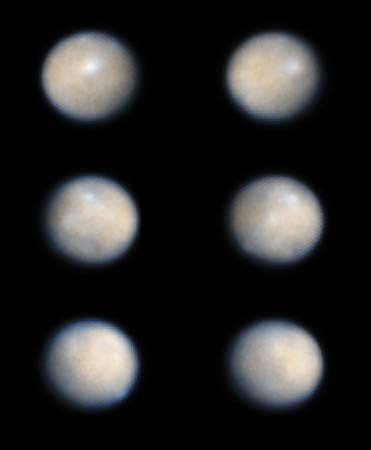Ceres
Roman goddess
 in Roman religion, goddess of the growth of food plants, worshiped either alone or in association with the earth goddess Tellus. At an early date her cult was overlaid by that of Demeter (q.v.), who was widely worshiped in Sicily and Magna Graecia. On the advice of the Sibylline Books, a cult of Ceres, Liber (Liber and Libera), and Libera was introduced into Rome (according to tradition, in 496 BC) to check a famine. The temple, built on the Aventine Hill in 493 BC, became a centre of plebeian religious and political activities and also became known for the splendour of its works of art. Destroyed by fire in 31 BC, it was restored by Augustus. The three chief festivals of Ceres' cult all followed Greek lines.
in Roman religion, goddess of the growth of food plants, worshiped either alone or in association with the earth goddess Tellus. At an early date her cult was overlaid by that of Demeter (q.v.), who was widely worshiped in Sicily and Magna Graecia. On the advice of the Sibylline Books, a cult of Ceres, Liber (Liber and Libera), and Libera was introduced into Rome (according to tradition, in 496 BC) to check a famine. The temple, built on the Aventine Hill in 493 BC, became a centre of plebeian religious and political activities and also became known for the splendour of its works of art. Destroyed by fire in 31 BC, it was restored by Augustus. The three chief festivals of Ceres' cult all followed Greek lines.dwarf planet
 dwarf planet and largest known asteroid in the asteroid belt and the first asteroid to be discovered. Ceres was found, serendipitously, by the Italian astronomer Giuseppe Piazzi (Piazzi, Giuseppe) of the Palermo Observatory on Jan. 1, 1801. Additional observations of the object by Piazzi were cut short by illness, but Ceres was recovered on Jan. 1, 1802, by the German Hungarian astronomer Franz von Zach (Zach, Franz Xaver, Freiherr von), using an orbit calculated by the German mathematician Carl Friedrich Gauss (Gauss, Carl Friedrich). Ceres was named after the ancient Roman grain goddess and the patron goddess of Sicily, thus beginning a long-standing tradition of naming main-belt asteroids after female characters from Greco-Roman mythology.
dwarf planet and largest known asteroid in the asteroid belt and the first asteroid to be discovered. Ceres was found, serendipitously, by the Italian astronomer Giuseppe Piazzi (Piazzi, Giuseppe) of the Palermo Observatory on Jan. 1, 1801. Additional observations of the object by Piazzi were cut short by illness, but Ceres was recovered on Jan. 1, 1802, by the German Hungarian astronomer Franz von Zach (Zach, Franz Xaver, Freiherr von), using an orbit calculated by the German mathematician Carl Friedrich Gauss (Gauss, Carl Friedrich). Ceres was named after the ancient Roman grain goddess and the patron goddess of Sicily, thus beginning a long-standing tradition of naming main-belt asteroids after female characters from Greco-Roman mythology.Ceres revolves around the Sun once in 4.61 Earth years in a nearly circular, moderately inclined (10.6°) orbit at a mean distance of 2.77 astronomical units (AU; about 414 million km 【257 million miles】). Although it—and the next two asteroids discovered, Pallas and Juno—are located near the distance predicted by Bode's law for the “missing” planet between Mars and Jupiter, most asteroids found subsequently are not so located, and so the agreement with this “law” appears to be coincidental.
Ceres has the shape of a flattened sphere with an equatorial radius of 490 km and a polar radius of 455 km, equivalent in volume to a sphere with a diameter of 940 km—i.e., about 27 percent that of Earth's Moon. Although Ceres is the largest asteroid, it is not the brightest. That honour belongs to the second largest asteroid, Vesta, which orbits closer to the Sun than Ceres (Vesta's mean distance is 2.36 AU) and has a surface reflectivity more than three times as high (its albedo is 0.34, compared with 0.10 for Ceres). The mass of Ceres, which accounts for more than one-third the total mass of the main asteroid belt, is about 9.1 × 1020 kg, and its density is 2.2 grams per cubic cm (about two-thirds that of the Moon). Ceres's shape and density are consistent with a two-layer model of a rocky core surrounded by a thick ice mantle. Ceres rotates once in 9.1 hours, showing no large-scale colour or brightness variations over its surface. Compositionally, the asteroid's surface resembles the carbonaceous chondrite meteorites.
Ceres was designated a dwarf planet, a new category of solar system objects defined in August 2006 by the International Astronomical Union. For a discussion of that decision, see planet.
- Petty, Sir William
- Petty, Tom
- petunia
- Petworth
- Petén
- Petén Itzá, Lake
- Petőfi, Sándor
- Peuerbach, Georg von
- Peutinger Table
- Pevensey
- Pevsner, Antoine
- pew
- pewee
- Pew, J. Howard
- Pew, Joseph N., Jr.
- pewter
- Pey de Garros
- Peyer patch
- peyote
- Peyo Yavorov
- Peyton Conway March
- Peyton Manning
- Peyton Randolph
- Peyton Rous
- Peć